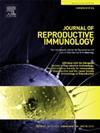细胞免疫与先兆子痫和早产的关系:孟德尔随机研究
IF 2.9
3区 医学
Q3 IMMUNOLOGY
引用次数: 0
摘要
越来越多的证据表明,免疫炎症失衡是子痫前期(PE)和早产(PB)发病机制的关键驱动因素,但特定免疫因素对这些疾病的影响在很大程度上还不为人所知。我们的目的是确定这些免疫细胞是否与子痫前期或早产的发病有因果关系。利用公开的遗传数据,我们采用孟德尔随机分析法探究了 731 个免疫特质(7 个面板:TBNK面板、调节性T细胞面板、T细胞成熟阶段面板、树突状细胞面板、B细胞面板、单核细胞面板和骨髓细胞面板)与 PE 和 PB 风险的因果关系。反方差加权法(IVW)是估计因果关系有效性的主要分析方法,并进行了敏感性分析以评估异质性和多义性。经FDR法调整P值后,CD24+ CD27+ B细胞上的CD27、浆细胞树突状细胞上的CD80、CD33+ HLA DR+ CD14dim绝对计数、CD33+ HLA DR+ CD14- 绝对计数、CD33+ HLA DR+ 绝对计数与PE风险增加有显著的因果关系,而树突状细胞上的HLA DR对PE有保护作用(PFDR < 0.05)。此外,我们还发现,髓系细胞中 CD33dim HLA DR- 上的 CD45 可降低 PE 风险,而粒细胞髓系衍生抑制细胞上的 CD11b 则对 PE 有相反的影响(FFDR < 0.2)。这项研究为免疫细胞特征与 PE 和 PB 之间的因果关系提供了遗传学证据,为今后研究妊娠并发症的病因提供了潜在的候选免疫表型。本文章由计算机程序翻译,如有差异,请以英文原文为准。
Association between cellular immune and preeclampsia and preterm birth: A Mendelian randomization study
Emerging evidences have highlighted immune-inflammatory imbalances as a critical driver of the pathogenesis for preeclampsia (PE) and preterm birth (PB), but the impact of specific immune factors on the diseases is largely unknown. Our aim was to determine whether these immune cells are causally associated with the onset of PE or PB. Drawing on publicly available genetic data, we applied Mendelian randomization analysis to probe the causal link of 731 immune traits (7 panels: TBNK panel, Regulatory T cells panel, Maturation stages of T-cell panel, Dendritic cell panel, B-cell panel, Monocyte panel and Myeloid cell pane) with the risk of PE and PB. The inverse variance weighting method (IVW) acted as the primary analysis to estimate the validity of causality, and sensitivity analyses were conducted to assessment of heterogeneity and pleiotropy. After adjusting for P-values for FDR method, CD27 on CD24+ CD27+ B cell, CD80 on plasmacytoid Dendritic Cell, CD33+ HLA DR+ CD14dim Absolute Count, CD33+ HLA DR+ CD14- Absolute Count, CD33+ HLA DR+ Absolute Count were remarkably causally involved in increased risk of PE, while HLA DR on Dendritic Cell exerted a protective causation against PE (PFDR < 0.05). Moreover, we determined that CD45 on CD33dim HLA DR- in myeloid cells decreased PB risk, whereas CD11b on Granulocytic Myeloid-Derived Suppressor Cells had the opposite effect on PB (FFDR < 0.2). This study provided genetic evidence for causal relationships between immune cell traits and PE and PB, offering potential candidate immunophenotypes for future studies on the etiology of pregnancy complications.
求助全文
通过发布文献求助,成功后即可免费获取论文全文。
去求助
来源期刊
CiteScore
6.30
自引率
5.90%
发文量
162
审稿时长
10.6 weeks
期刊介绍:
Affiliated with the European Society of Reproductive Immunology and with the International Society for Immunology of Reproduction
The aim of the Journal of Reproductive Immunology is to provide the critical forum for the dissemination of results from high quality research in all aspects of experimental, animal and clinical reproductive immunobiology.
This encompasses normal and pathological processes of:
* Male and Female Reproductive Tracts
* Gametogenesis and Embryogenesis
* Implantation and Placental Development
* Gestation and Parturition
* Mammary Gland and Lactation.

 求助内容:
求助内容: 应助结果提醒方式:
应助结果提醒方式:


